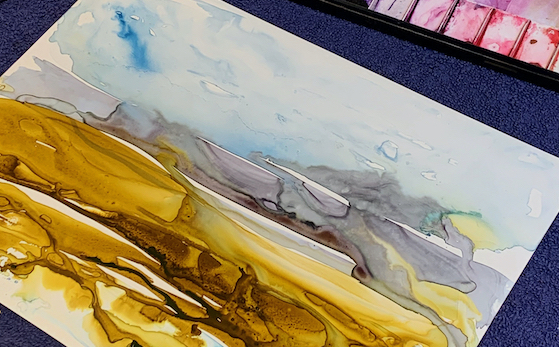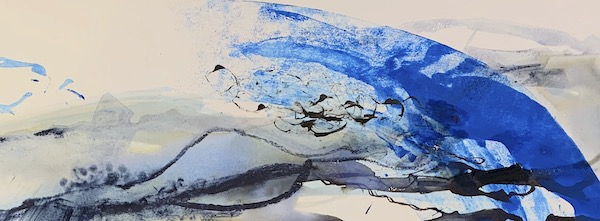Planning an art residency to get results
Planning an art residency is the key to making sure you make the most of the opportunity. This January, I went on a week’s residency to the Ballinglen Art Foundation with two artist friends.
It’s difficult to describe just how much this trip moved my work. That’s mainly because I am still working through ideas and the processes I started. The bonus of travelling together and sharing a house became apparent when we realised how much discussion happened in between studio days. Sharing stories of our experiences, of what worked and what didn’t, looking at paintings we’re each drawn to and talking about why we like them. All these conversations were so valuable.
To make sure it really delivered, this one week of studio time was almost 6 months in the planning. And the planning was all worth the effort.
Are you planning an art residency?
Here’s are some aspects you might want to consider:
Decide who is going?
This was easy in our case, because it started with the idea that we wanted to work together in a residency. But we did have a discussion about whether to open it up to other artists. We decided not to as on this occasion a small group was easier to organise. Consider whether anyone in the group is likely to find it difficult to hear feedback. We agreed up front that we would be honest and constructive in our comments – which only works well within a group of artists who are able to put their egos aside. Feedback is critical to growth, so we were all happy to share our thoughts.
Where will the residency be held?
There any many factors to consider here:
- Is there the right type of studio space? Equipment may be included. It helps not to have to cart easels with you.
- Is the accommodation suitable? What are your expectations, and can you adapt if it’s not quite what you were expecting?
- How much time will be spent travelling? This could still be very useful time. It was in our case.
- Does the distance mean that there will be constraints on what materials can be taken?
- If this is a self-organised residency, what is the cost?
What does each artist want to get out of the week?
This is a big question that requires some careful individual reflection. It is helpful if everyone wants a similar outcome, but not essential. Make a note of what outcome will make the residency successful for you. Share this within the groups so that everyone knows what the goals are.
Decide on what materials to take
In our case, two of us had to fly to get to the residency so materials and tools were limited to what we could fit into our suitcases (alongside our clothing). My suitcase content was about 50% art materials – It’s not unusual for me to pack light on the clothing so I can put in more paper and paint.
Flying also meant we had to use fast drying paints so they could be packed back into our cases.
How are domestic arrangements going to be handled?
Artists have to eat – even on a residency. The less time is spent on grocery shopping and cooking, the more time there is for working in the studio. Planning an art residency also means planning how you’re going to split these tasks, and the cost of food. Cooking together can provide valuable discussion time, so it’s not necessarily wasted time. It’s just useful to know how this aspect will work before you get there.
Our residency: how it went.
We were fortunate to be offered a week’s collective residency at Ballinglen which has an international reputation, spectacular surroundings, and an art library of note. Having a residency in Ireland meant the oil painter in our group could take canvasses and oil paints from her studio. The other two of us work predominantly in water-based media.
We all wanted to develop our abstract work. This proved useful because we could focus our discussions on shape and colour, process and materials, and review which other abstract artist work we liked. We didn’t feel we needed to be aligned on what we like. That’s a matter of personal taste.
The weather was awful and there were a few physical challenges, but we overcame them without too much problem. A little adversity makes the experience more memorable. The week flew past and we all made progress in our work: Brighter colours for one. Simplification for another. And for me, some time working on layering and colour combinations in acrylics. None of the pieces I brought back were finished work. I have a pile of colour studies in my studio that I will use as reminders of what worked and what didn’t quite make it for me.
Although it seemed to go incredibly fast, I think the five studio days on top of the discussion time in between were an ideal amount of time. We’ve got enough to reflect on and add into our process. And that, after all, was the primary objective.
Planning a residency: final thoughts
If you’re going in winter, there’s always the possibility that bad weather will disrupt your transport. (I got stuck in Ireland for an extra day because storm Isla made flying too dangerous).
Before you go home, if you’ve enjoyed your residency, start planning an art residency for the next time we want to create a big shift in our work.
Thank you to my fellow art residents, Caroline Murtagh and Carol Pairaudeau for sharing their ideas and experiences with such generosity.
Share this:
Recent Posts
Recent Comments
- vandy on From pulp to perfection: The art of making watercolour paper
- What Is Watercolor Paper? | Print Wiki on From pulp to perfection: The art of making watercolour paper
- Jessica on Cleaning Used Acrylic Painting Water
- vandy on What my art taught me about myself
- Terri Webster on What my art taught me about myself
Archives
- October 2024
- May 2024
- March 2024
- January 2024
- October 2023
- May 2023
- January 2023
- December 2022
- November 2022
- October 2022
- September 2022
- September 2021
- July 2021
- June 2021
- May 2021
- April 2021
- March 2021
- February 2021
- January 2021
- December 2020
- November 2020
- October 2020
- September 2020
- August 2020
- July 2020
- June 2020
- April 2020
- March 2020
- December 2019
- November 2019
- October 2019




